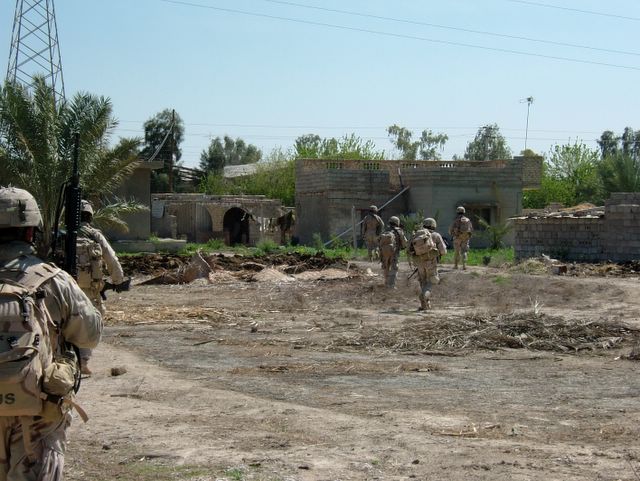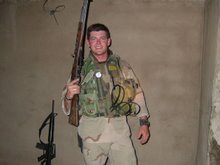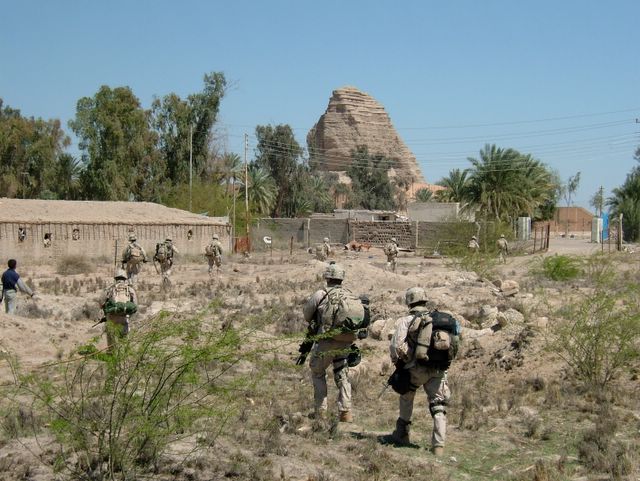Iraq Progress Report
Below is some information from USAID as to what has been accomplished in Iraq since the Coalition invasion. This does not include the fact that Saddam Hussein has been detained and removed from power and is currently standing trial for his actions, that there is an independ Iraqi Army and Police Force standing tall next to Coalition forces protecting Iraqi citizens, and Iraqi nationals have been elected by their peers to govern various provinces. It has been three years. We won the war against Saddam Hussein and are now fighting a war on terrorism. You won't find any of this in the mainstream media. If you ask me, for three years, we are fast tracking!
Education:
-Through September 2005, over 2,800 schools have been rehabilitated, and 45 constructed.
-Internet access and computers have been installed at the Ministry of Education and in all 21 Directorates of Education. To improve planning and resource management, official baseline data has been gathered and an Education Management Information System (EMIS) is being developed.
-Over 47,500 secondary school teachers and administrators nationwide have received training.
-More than 80 primary and secondary schools are being established to serve as model schools. At these “centers of excellence,” teachers will receive up to five weeks of training, and schools will be equipped with computer and science laboratories.
-Hundreds of thousands of desks and chalkboards have been distributed countrywide.
USAID edited, printed, and distributed 8.7 million Iraqi math and science textbooks.
-More than 550 out-of-school youths completed a pilot accelerated learning program. An expanded program, targeting more than 11,000 youths, is being implemented during the 2005–06 school year.
-School supplies have been distributed to one million primary school children and two million secondary; sports equipment has been distributed to every school.
-An early childhood learning television series is currently being developed.
-Through university partnerships, more than 1,500 Iraqi faculty and students at 10 Iraqi universities have participated in workshops, trainings, conferences, and courses in Iraq, the greater Middle East, Europe, and the United States.
-At 10 Iraqi universities, USAID has rehabilitated and equipped 23 specialist libraries, 23 computer laboratories, 20 specialist science labs, and 17 auditoriums or classrooms. These efforts have benefited approximately 50,000 university students in colleges of law, engineering, medicine, archeology, and agriculture. In addition, books and electronic resources have been provided to university libraries.
Healthcare:
Reestablishing essential primary health care services:
-2005 emergency campaigns supported the immunization of 98 percent of children 1-3 years (3.62 million children) against measles, mumps, and rubella. As a result, there has been a 90 percent reduction in laboratory confirmed cases of measles between 2004 and 2005.
-97 percent of children under five (4.56 million) immunized against polio during the 2004-05 national polio immunization campaign, enabling Iraq to maintain its polio-free status.
-Vaccinated 3.2 million children under five and 700,000 pregnant women, with UNICEF and WHO.
-Provided supplementary doses of vitamin A for more than 1.5 million nursing mothers and 600,000 children under two, and iron folate supplements for over 1.6 million women of childbearing age.
-Trained 11,400 staff at over 2,000 community child care units to screen for malnutrition and to provide monthly rations of high protein biscuits to malnourished children and pregnant mothers.
-Renovated 110 facilities and equipped 600 centers with basic clinical and lab equipment.
-Trained over 2,500 primary health care workers, improving access to essential primary health care.
Building Capacity and Strengthening Health Services:
-Provided skills training to 3,200 primary care providers and physicians, improving service delivery.
-Trained 2,000 health educators, teachers, religious leaders, and youths to assist in mobilizing communities on hygiene, diarrhea, breastfeeding, nutrition, and immunization issues.
-Established training and education centers in five governorates to support local health care training.
-Vaccines and cold chain equipment provided to selected remote health centers along with training of staff and social mobilization has increased routine immunization coverage from 60 to 74 percent.
-Minimized epidemics by re-establishing Iraq’s disease surveillance and response system. Addressed urgent water and sanitation service needs to prevent disease outbreaks: Other USAID programs, particularly in water and sanitation, have immensely contributed to improvements in Iraqi health. USAID partners have repaired 1,700 breaks in Baghdad’s water distribution network. Key supplies have been procured to service water treatment facilities in Baghdad and other cities. Water treatment facilities across four governorates have been rehabilitated. Over 100 sewage pumping stations, rainwater stations, and collapsed sewer lines have been repaired countrywide.
Water and Sanitation:
Nationwide:
-Restored or provided new water treatment to over 2.4 million Iraqis and sewage treatment to over 5.1 million.
Baghdad:
-Expanded Sharq Dijlah water plant by 50 MGD and rehabilitated three sewage plants, which serve 80 percent of Baghdad's population, thus eliminating dumping raw sewage into the Tigris.
-Kerkh wastewater treatment plant (WTP) began operating on May 19, 2004, the first major Iraqi plant to operate at full capacity in more than 12 years.
-Standby generators have been procured and installed at 27 Baghdad water facilities, ensuring continued supply of treated water in the event of power outages.
-Refurbished existing sewage lines and pump stations serving the Kadhamiya area of western Baghdad.
South:
-Rehabilitated the Sweet Water Canal system: repairing breaches, cleaning and repairing the main water storage and settling reservoir and refurbishing 14 water treatment plants around Basrah city.
-Treated water production increased by over 100 percent, serving over 1.1 million additional people.
South Central:
-Rehabilitated two water plants and four sewage plants.
-Najaf, Diwaniyah, Hillah, and Karbala sewage plants serve nearly 1 million people.
-Water treatment plants in Najaf and Karbala serve more than 375,000residents and pilgrims near one of Iraq's holiest shrines.
North:
-Provided major equipment for Mosul Water and Sewer Directorates.
-Refurbished the Kirkuk WTP.
Roads and Bridges:
-The Al Mat Bridge is a key link on the main highway between Baghdad and Jordan used by more than 3,000 trucks daily. Work was completed and the bridge was reopened to two-way traffic on March 3, 2004.
-The Khazir Bridge is critical to the flow of fuel and agricultural products in northern Iraq. The bridge’s four lanes were completed on May 1, 2004.
-The Tikrit Bridge is an important link for passengers and commerce over the Tigris River between Tikrit and Tuz Khurmatu. This two-lane bridge was reopened to traffic on September 15, 2004.
-In addition, USAID also repaired a floating bridge over the Tigris River at Al Kut, improving traffic for 50,000 travelers a day.
Railroads:
-USAID’s partner completed an assessment of over 1,100 kilometers of railroad track and rail facilities throughout the country to identify priority projects. Proper rail construction and maintenance is vital in Iraq; rails can expand significantly during the heat of the day. If not done correctly, the rails will bow in the heat and cause trains to derail.
-USAID also assisted with the construction of 72 kilometers of new track and rail facilities between the Port of Umm Qasr and Shuaiba Junction, located west of Basrah, and connecting to the Baghdad trunklines. This project was a joint US-Iraqi effort; USAID constructed the civil facilities and provided project management and materials, and the Iraqi Republic Railways contributed project designs and materials, and supervised construction. Reconstruction of the line was completed in April 2004 and will increase the reliability of grain and other cargo shipments from Umm Qasr Port to storage silos and warehouses throughout the country.
Telecommunications:
-Audited more than 1,200 km of the national fiber optic backbone network.
-Performed emergency repairs to the national fiber optic network from Mosul to Umm Qasr, connecting 20 cities to Baghdad and the 70 percent of Iraqis that have landline telephone accounts.
-tools, equipment, and parts and provided management oversight to assist ITPC in the restoration of the fiber optic network.
-Replaced obsolete transmission equipment between Baghdad and Basrah in collaboration with the ITPC.
-Reconstituted Baghdad area phone service by installing switches with 240,000 lines at 12 sites.
-In total, USAID installed 12 domestic switches and one international switch, fully integrating the new equipment with the existing switches. The switches provide connection points for ITPC to connect subscribers.
Installed a satellite gateway system and restored international calling service in December 2003.
-Trained ITPC engineers and technicians in the operation and maintenance of the satellite gateway system and the new telephone switches.
http://www.usaid.gov/iraq/accomplishments/












